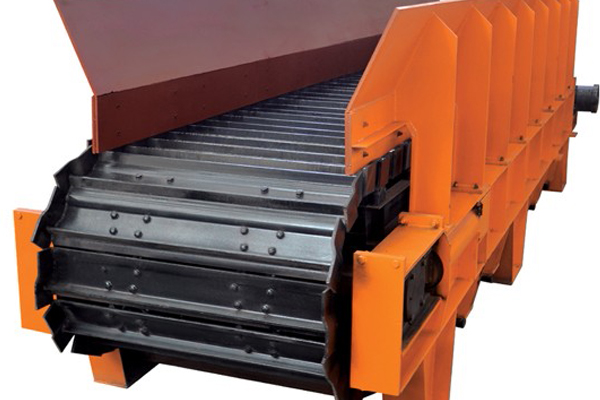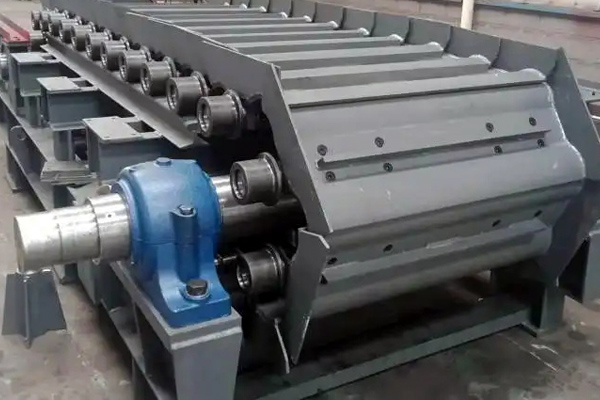Apron Feeder is a continuous conveying machine designed to feed raw ore for primary crushing or to transfer bulk materials steadily. It continuously and evenly delivers materials from the storage bin to crushers, conveyors, or other processing machines along horizontal or inclined paths.
Structure Of Apron Feeder
- The apron feeder consists of several major components: a silo interface, guide trough, gate device, transmission chain assembly (chain and plates), drive motor, sprocket group, and chassis.
- All components connect firmly with bolts, allowing easy assembly and disassembly for both surface and underground installations.
- The guide trough, positioned beneath the silo, directs material toward the transmission platform. The drive sprocket group, mounted on the chassis, includes a motor, reducer, bearings, and chains. Operators can use the manual flat gate to control discharge opening size and regulate feeding quantity.
- At the return end, a tensioning device adjusts the chain’s alignment and maintains smooth parallel operation. The frame on both sides supports the returning chain plates through downward slides, ensuring balance and stability.
Apron Feeder : Working Principle
When materials fall from the silo into the guide trough, the drive motor activates the sprocket system, pulling the connected chain plates forward. The moving chain plates carry the material steadily toward the discharge point, completing the feeding process.
Operators can regulate the feeding rate and output by adjusting the gate opening or the frequency converter’s speed setting. To prevent leakage, sealing plates on both sides of the trough close the gaps between the sprocket and chain plates.
Apron Feeder : Performance Features and Application
The apron feeder operates with low power consumption and reduced noise, yet provides a large feeding capacity. It ensures stable, adjustable, and continuous feeding. Its modular design features interchangeable parts, simplifying maintenance. Moreover, it offers high efficiency, energy savings, explosion-proof safety, and environmental protection—making it a modern and reliable feeding solution.
Medium-Duty apron feeders handle both block and loose materials effectively. They transport materials from storage to the next processing stage, ensuring smooth and continuous flow. Widely apply them in industries such as mining, metallurgy, cement, and building materials, where stable feeding is essential for production efficiency.
Transmission and Control System
The medium-Duty apron feeder uses a variable-frequency speed-regulating motor directly connected to a hard-tooth gear reducer. This design simplifies the structure, improves power transmission efficiency, and ensures reliable performance.
The variable frequency control system allows smooth adjustment of feeding volume. Its constant torque output adapts to changing load conditions and variable material flow. As a result, the connected equipment receives materials evenly and operates stably. This feature promotes system automation and satisfies diverse production requirements across a wide range of applications.
Conclusion
The apron feeder serves as a quantitative feeding device within continuous bulk conveying systems. Engineers classify it into three types—heavy-duty apron feeder, medium-duty apron feeder, and light-duty apron feeder — based on material characteristics and production scale.
Due to its durability, precision, and reliability, the apron feeder has become indispensable in industries such as mining, metallurgy, and building materials. It ensures continuous, controlled, and efficient material flow, forming a critical foundation for modern raw material processing and automated production systems.

